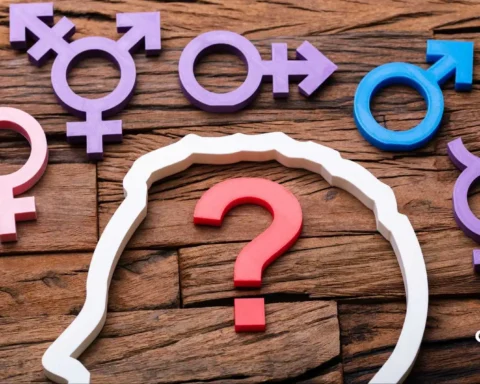The ‘me’ you know, is just an ubiquitous assimilation of thoughts, ideas, beliefs, practices. What you are will perpetuate itself until you are aware of the fact that what you think you are is just a conditioned version of you. Therefore, the real problem in approaching the truth is our images, which man collects in memory and identifies as me. These inner images and inherited perceptions are among the subtle factors affecting self-identity, determining how a person perceives their sense of self.
Table of Contents
Factors Affecting Self-Identity: The Search Within
In an illusioned world, the self beneath the image is hard to find, even harder to be with, for it is more likely to slip into the oblivion of falsehood. Man wears a pretence of his subjective configuration of self, until his cognitive revelation knocks his consciousness. This consciousness, untamed, will require a gigantic amount of pure perception just to discern what is innate consciousness and what is acquired. These layers of pretence and perception are psychological factors affecting self-identity, constantly shaping one’s understanding of who they are.
The Conditioning of Thought
You see your classmates score higher marks or get praised. A thought forms, “I am not good enough.” Later, when you do well, the opposite thought appears, “Maybe I’m.” Both are mental pictures of yourself that become part of your identity, though they are only reactions. You were told since childhood, “Success means having a stable job.” This belief settles quietly in your mind. When you grow up and want to become an artist, that old belief resists, “That’s not practical.” You think this hesitation is “you,” but it’s actually a borrowed idea functioning inside consciousness.
A friend once betrayed your trust. Now, when you meet someone new, a thought instantly arises, “I can’t trust people.” That conclusion becomes part of the “me”, a psychological scar stored as memory, influencing how you relate to others. These are emotional and social factors affecting self-identity, forming patterns of thought that influence behaviour and self-perception.

The Mirror of Relationship
Krishnamurti says, “Truth is a pathless land”, which decodes to the fact that truth can’t be reached by creed, beliefs, priests, rituals, organization, dogma, philosophical knowledge, or psychological techniques. To attain the primordial knowing, one has to unravel the path oneself, in the absence of any external aid. A relationship is the mirror of understanding oneself. Relationship is the crucible in which consciousness confronts the architecture of its own being. It is not just an exchange of emotions or words but a metaphysical mirror in which the psyche observes its own reflection.
When one looks at another with affection, resentment, or desire, it is not the other that is revealed first, but the hidden topography of oneself. Each interaction becomes one of the relational factors affecting self-identity, revealing how the self is formed through the presence of others. Emotional reactions and mirrored perceptions are thus essential factors affecting self-identity, constantly redefining how individuals perceive their consciousness.
The Ocean of Reflection
Imagine two mirrors facing each other; between them, images multiply into infinity, yet none possesses substance. Such is the field of relationships. The “me” looks at the “you,” but what it often perceives is the vibration of its own thought. When jealousy arises, it is not born of the other’s act but of one’s own insecurity seeking form. When admiration arises, it is the self projecting its dormant ideals onto another vessel.
Relationship, in this sense, is an ocean of reflections. The waves may appear separate, but they belong to the same depth. Through every collision of temperament, the surface trembles, and for a fleeting instant, the depths become visible. It is in these moments of turbulence that awareness dawns, the realization that the other is not a stranger but a continuation of oneself, refracted through a different lens of experience.
Living Within and Beyond Relationship
To live outside a relationship is to dwell within the glass walls of isolation, where thought only circles upon itself. But to live within it consciously is to stand before a mirror that never flatters nor condemns, only reveals. Thus, the relationship becomes both the scripture and the stage of self-discovery- the arena where the self dissolves into awareness, and understanding flowers not as an idea, but as a living perception.
Thought and Time
Thought is the offspring of time, conceived in the womb of memory and nurtured by experience. It carries within it the sediment of the past, each idea a fossil of what has already been. In its motion, thought drags the remnants of yesterday into the texture of today, transforming the living moment into a museum of recollections. Thus, time, as conceived by the mind, is not a flowing river but a stagnant reservoir where consciousness drowns in its own reflection.
Perhaps freedom begins where time ceases to dictate. When the mind no longer carries the debris of yesterday into the freshness of today, life resumes its unpremeditated motion. The leaf trembling in the wind, the laughter that erupts without motive, these moments exist outside the tyranny of psychological time. To live without becoming is not inertia but pure presence, where the self dissolves into the immediacy of being, untouched by the architecture of memory.

The Epistemological Dilemma of Self
The question, “Who am I, really?” is not a sentimental inquiry but a profound epistemological dilemma. The self is neither a static entity nor an autonomous essence but an ever-shifting constellation of psychological, cultural, and experiential coordinates. Identity, in its apparent solidity, is in fact a collage assembled from inherited symbols, linguistic frameworks, and the sedimented impressions of memory. The individual becomes the theatre upon which social narratives, genetic predispositions, and personal volition perform their intricate play. Each experience inscribes itself upon the psyche, forming a palimpsest in which older scripts are never fully erased, merely overwritten by new ones.
Thus, the “I” is not an origin but an outcome, a synthesis continually revised by the flux of perception and context. To ask Who am I? is to confront the paradox of selfhood that the perceiver and the perceived are the same movement of consciousness, and that the very act of defining oneself confines the limitless fluidity of being into the narrow architecture of thought.
The Global Indian Lens: Why Self-Identity Matters More Than Ever
For the Global Indian community, self-identity isn’t just personal; it’s generational, cultural, and often political. Living between worlds means constantly balancing inherited traditions with adopted values, and navigating how “Indianness” evolves across continents. The factors affecting self-identity, suchas family expectations, societal perception, language, and representation, take on unique dimensions when distance and diaspora come into play.
For many, identity becomes a negotiation between pride and belonging: how to stay rooted without feeling restricted, how to integrate without feeling erased. As migration accelerates and second- and third-generation Indians define their place in a global narrative, understanding these forces isn’t optional; it’s essential. The strength of the Global Indian identity lies not in uniformity, but in its fluidity, the ability to adapt, absorb, and redefine what it means to be Indian in a world that’s constantly reshaping itself.
Conclusion
The inquiry into factors affecting self-identity is not a quest for a final definition but an unending exploration of awareness. Every attempt to name or describe oneself merely creates another image within thought, another mask that conceals rather than reveals. The true understanding of who we are does not come from intellectual reasoning or accumulated knowledge but from direct perception, seeing without the interference of judgment or memory. When we begin to observe ourselves in relationship, in silence, in the simple acts of daily life, we catch glimpses of a consciousness unshaped by comparison, fear, or desire.
In that awareness, the boundaries between “I” and “you” begin to dissolve, revealing a deeper unity beneath the illusions of separation. To know oneself, therefore, is to let go of every borrowed idea, every fragment of conditioning that defines the self as something fixed. It is to live freely in the flux of being, where understanding arises naturally, without effort or conclusion.
Asking who you are is hard, for you will remain unanswered. Try to torch up your mind- you’ll surely find your answer.

FAQs
What is self-identity?
Self-identity refers to how a person perceives and defines themselves based on their beliefs, experiences, values, and interactions with the world.
What are the main factors affecting self-identity?
Culture, family, social environment, education, relationships, and personal experiences all play key roles in shaping one’s self-identity.
How do relationships influence self-identity?
Relationships act as mirrors through which individuals understand their emotions, behaviour, and sense of belonging. They help us recognize who we are and who we are not.
Why is it difficult to define who we truly are?
Because our thoughts and identities constantly evolve with time and experience, any definition becomes temporary and incomplete.









